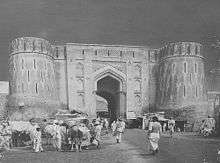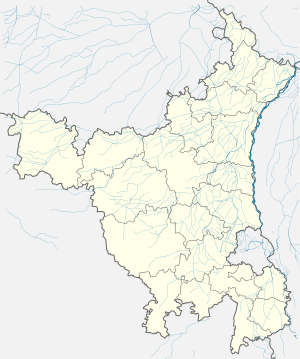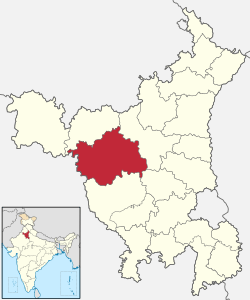Asigarh Fort
Asigarh Fort, also called Hansi Fort is located on the eastern bank of Amti lake in Hansi town of Haryana, India, about 135 km from Delhi on NH9. It is also known as Prithviraj Chauhan's Fort or Prithvi Raj Chauhan Ka Qila and has been declared a centrally protected monument by ASI.[1]
| Asigarh Fort | |
|---|---|
| Prithviraj Chauhan's Fort | |
 | |
| Location | Hansi, Haryana, India |
| Coordinates | 29°6′19″N 75°57′47″E |
| Area | 30 acres (12 ha) |
| Height | 52 feet |
| Built | 12th century |
| Built for | Prithviraj Chauhan |
| Demolished | 1857 |
| Restored | 1937 |
| Restored by | Archaeological Survey of India |
| Architectural style(s) | Hindu |
| Governing body | Archaeological Survey of India |
 Location of Asigarh Fort in Haryana  Asigarh Fort (India) | |
Spread over 30 acres, in its prime days this fort used to be in control of 80 forts in the area around it.[2] Likely built by emperor Harshvadhana's dynasty, it passed to Tomar and then Chauhan kings before falling in the hands of Delhi Sultanate, Maratha Empire, Jat Sikhs, independent European adventurers, and British Raj.
Etymology
_%2C_19th_century.jpg)
Asigarh the fort of swords, from Asi (sword) and garh (fort), as this was the centre of sword making from the ancient times of Hindu rulers.
There are several names used for the fort in different anecdotes, such as Asidurga, Asigarh, Asika, A-sika, Ansi, Hansi, etc., and local oral traditions derive these names from Assa Jat.[3]
History
Antiquity
Hansi fort or Asigarh Fort has long history with little clarity about the earlier period. The excavation of ancient coins belong to the BCE period shows that there have been long history of settlements on the mound on which fort is built.[4] It is believed that original fort was built by the famous emperor Harshavardhana or his grandfather emperor Prabhakaravardhana of Pushyabhuti dynasty (Vardhana). The present fort was built with materials of earlier fort of a period about 7th century C.E.
In February 1982, a large hoard of Jaina bronzes including idols belonging to the Gupta period (319 to 605 CE) and 7th–8th centuries (a period belonging to the emperor Harshavardhana's Pushyabhuti dynasty, c. 500 to 647 CE) were discovered.[5]
Tomar rule
As per British library, Asigarh fort has been believed to have been founded by Anangpal Tomar of Tomara dynasty, the Tomar king of Delhi.[6] Multiple (three) Tomara kings seem to have shared the name "Anangapala" (IAST: Anaṅgapāla).[7] Around 1000 CE, Asigarh, Haryana and Delhi were in control of emperors of Tomara dynasty,[8] when in 1014 Mahmud Ghazni attacked Thanesar and Hansi where he mass destroyed Hindu temples, and again in 1025 he also attacked Somnath temple and Jat people of Jud.[9][10] Mahmud Ghazni had sent his son Mas'ud I of Ghazni to attack Hansi in 1037 CE, when Masud attacked swordsmen of Hansi and took Hindu women into slavery who were later sold at Gazni.[5] In 1041 in revenge for murder of his father, Mahmud Ghazni's nephew Mawdud of Ghazni (r. 1041-50 CE) seized the throne from his uncle Mahmud Ghazni. Mahipal Tomar of Tomar dynasty which ruled this area from Delhi the 11th century recaptured Hansi and Thanesar regions from Mawdud, and based on fragmentary Tomara inscriptions discovered from Mahipalpur in Delhi it has been theorized that Mahipala established a new capital at Mahipalapura (now Mahipalpur).[8]
Chauhan rule
According to the Bijolia inscription of Someshvara of Chauhan dynasty, his brother Vigraharaja IV had captured Dhillika (Delhi) and Ashika (Hansi). He probably defeated the Tomar king Anangapala III.[11] Later, the fort was reconstructed by Prithviraj Chauhan in the 12th century. The fort was again built by George Thomas in 1798 when he carved out his own kingdom consisting of Hisar and Rohtak districts with capital at Hansi.[4] British Indian Army built a cantonment in this fort after George Thomas surrendered to British Raj in 1803.[4] During the revolt of 1857, the cantonment was abandoned and the fort was damaged.[4] The prisoners of the Kuka movement were imprisoned in this fort during the 1880s.[12]RULED BY CHAUHAN RAJPUTS THEN..
Muslim rule
In 1192, after the defeat of Prithviraj Chauhan by Mohammed Gauri, Hindu rule ended in Hansi.
Sikh and Maratha rule
In 1705 during the time of Aurangzeb, Guru Gobind Singh toured Hansi to inspired the people to revolt against the oppressive Mughal rule.} In 1707, Baba Banda Singh Bahadur attacked Hansi. In 1736, the fort was under Maratha rule. In 1780s Maharaja Jassa Singh Ramgarhia also took this area under his control for some years as a Maratha vassal and then left.
British colonial rule
From 1798 to 1801, George Thomas, an Irish immigrant who rose from an ordinary sailor, usurped the area around Hansi and made Asigarh fort his capital.[13][14]
In 1802 after the Anglo-Maratha Wars, the British East India Company rule seized the fort, but did not take control until 1810 and after which they controlled it till independence of India in 1947.
In 1803 Hansi was also the headquarters of Colonel James Skinner CB (1778 – 4 December 1841) the Anglo-Indian military adventurer in India, who founded 1st Skinner's Horse and 3rd Skinner's Horse at Hansi in 1803. These units are still part of the Indian Army.[15] in 1818 was granted a jagir of Hansi (Hisar district, Haryana), yielding Rs 20,000 a year.[16]
Hansi took an active part in the 1857 war of liberation (Gadar), Lala Hukam Chand Jain was martyred in 1857 by Britishers.
Monuments and architecture
The fort is said to be one of the most impregnable forts of ancient India[4] The walls of the fort are 52 feet (16 m) high and 37 feet (11 m) thick. At the south end of the fort is a big gate added later by George Thomas.[4] The carvings on the walls assign it to be of Hindu origin.[1]
Main gate
The main gate has the beautiful carvings of birds, animals and Hindu deities.[17] An inscription there says it was repaired by Alauddin Khilji in 1304.[2]
Baradari
Long pillared structure with a flat roof is situated on the top of the mound and is known as Baradari.[1]
Char Qutub Dargah
A mosque is also located inside the fort complex which was added after the defeat of Prithviraj Chauhan.[4]
Conservation
It was declared a national monument in 1937.[17] In December 2018 Government of India commenced the conservation work to cleanse and preserve the buildings, including "Ghoda Ghar" (horse stable) and main gate, starting cleaning with the Non-ionic detergents and finishing it with a coating of pollution, fungus and rainproof polyment resin.[17]
References
See also
| Wikimedia Commons has media related to Asigarh Fort. |
External links
- Field study and documentation by American Institute of Indian Studies in Jan-Feb 2010.
- Video: Asigarh Fort, 7.40m.
- 51-image online picture gallery of Asigarh fort taken by American Institute of Indian Studies in 2008 CE
- Online picture gallery of Indo-Islamic monuments of Haryana taken by American Institute of Indian Studies in 2008 CE
- Images of Asigarh Fort on ASI website
Citations
- Barnett, Lionel (1999). Antiquities of India. Atlantic.CS1 maint: ref=harv (link)
- Dilip Kumar Ganguly (1984). History and Historians in Ancient India. Abhinav. p. 117. ISBN 978-0-391-03250-7.CS1 maint: ref=harv (link)
- Khan, Iqtidar Alam (2007). "Ganda Chandella". Historical Dictionary of Medieval India. Scarecrow Press.CS1 maint: ref=harv (link)
- Upinder Singh (2008). A History of Ancient and Early Medieval India: From the Stone Age to the 12th Century. Pearson Education India. ISBN 978-81-317-1120-0.CS1 maint: ref=harv (link)
- "History of Hisar". District Administration, Hisar. Archived from the original on 4 February 2012. Retrieved 3 July 2012.
- Planning a vacation? Here's why you should visit Hansi in Haryana or go trekking in Kemmanagundi, Economic Times, 3 Nov 2016.
- 2001, Devendra Handa, "JAINA BRONZE Hoard from HANSI A preliminary Study", Roopa-Lekhā, Volumes 67-71, Fine Arts & Crafts Syndicate Limited, I.M.H. Press, Delhi, page 1.
- "Gazetteer of Hisar" (PDF). Revenue Department, Government of Haryana. Archived from the original (PDF) on 1 May 2014. Retrieved 3 July 2012.
- Jaina Bronzes From Hansi, by Devendra Handa, Indian Institute of Advanced Study, 2002
- The fort at Hansi, the Union flag flying from the top
- Upinder Singh 2008, p. 570.
- P. C. Roy 1980, pp. 93-94.
- Barnett 1999, p. 74-78.
- Khan 2007, p. 66.
- Dilip Kumar Ganguly 1984, p. 117.
- Singh, Jaswindar (1985). Kuka Movement: Freedom Struggle in Punjab, Documents, 1880-1903 A.D. New delhi: Atlantic Publishers. p. 217. Retrieved 6 August 2015.
- Desi Irish Raja of Haryana, TIme of India newspaper, Jul-24-2016
- Military memoirs of George Thomas, William_Francklin, 1805
- Colonel James Skinner CB Archived 18 December 2010 at the Wayback Machine National Army Museum (British Army).
- Chisholm, Hugh, ed. (1911). . Encyclopædia Britannica. 25 (11th ed.). Cambridge University Press. p. 192.
- पुरातत्व विभाग Rs.10 लाख से स्मारकों की करवाएगा वाशिंग और कोटिंग, किले के मुख्य द्वार पर काम शुरू, Dainik Bhaskar, 10 Dec 2018.

